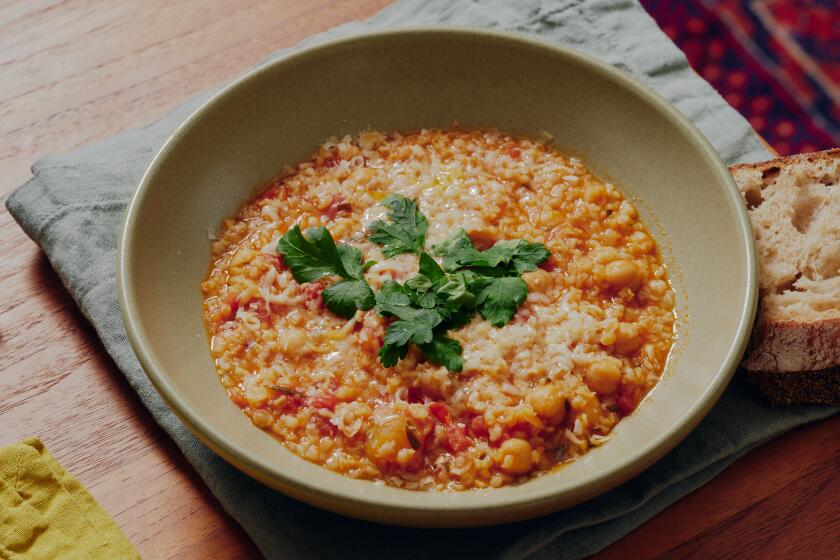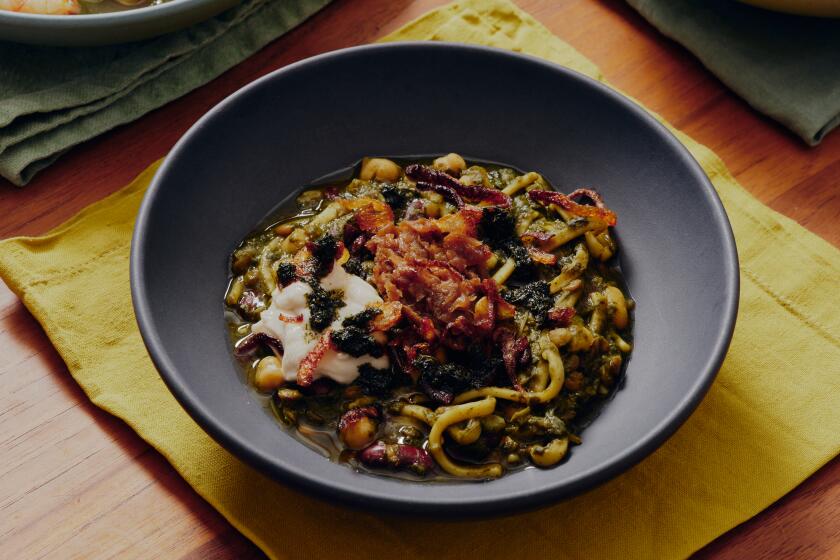Cold Tomato Soup (Salmorejo)
Seville, Spain -- If you ask Spaniards what their favorite food is, the answer will probably have something to do with a pig--fresh or cured, roasted whole or ground into sausage. The Spanish affection for pork knows no limits.
Of course, the answer could be even simpler: jamon, the Spanish equivalent of prosciutto. These dark crimson, explosively flavorful hams are the crown jewel, the pot of gold at the end of the Spanish culinary rainbow. No wedding is complete without jamon, no holiday is celebrated without jamon, and a tapas bar without it wouldn’t deserve the name.
Jamon is omnipresent in Spain. And as the most beloved food in a cuisine that increasingly is becoming the focus of the world’s attention, it almost inevitably will become so elsewhere as well.
In Spain, the violin-shaped pork legs hang everywhere, in restaurants, small bars, grocery stores, markets and the pantries of people like my friend Paca. Her family has a small meat-processing factory where they cure hams, make sausages and prepare other kinds of cold cuts to sell to regional butchers. If you ask for a ham sandwich at her house, she goes into her pantry with a knife, slices off a few pieces of meat from her jamon, slaps them on a sliced roll and hands you your sandwich. (Though the trimmings of jamon may be used for cooking, the meat itself is almost always served unadorned.)
At the meat-processing factory the jamones are cleaned and placed in a vat of salt for one day per kilogram of weight. Then they are hung to cure in a room that is controlled for temperature and humidity.
Exactly when a jamon is ready is difficult for an outsider to tell. All jamones are sold, the producers say, “at the right time.” I have tried and tried to find out what “the right time” means but received only another equally vague answer--the color of the meat has to be the right shade of dark red and the fat a bright white. I suppose that with years of experience you learn the definitions of “the right time,” dark red and bright white.
One thing even a beginner can understand: When jamon is “just right,” it melts in your mouth like butter.
The usual jamon serrano, made from the white-footed pig, is delicious, but if you really want to impress a Spaniard, serve the kind made from the black-footed pig--the famed pata negra or Iberico. Jamon Iberico is so revered that many Spanish families make a day’s outing out of a shopping trip to Jabugo in the southwest of Spain or to Guijuelo in the central northwest, two villages famous for their excellent jamon Iberico.
The Spanish raise two types of pigs popularly known as white and black pigs. The black-footed Ibericos, a breed native to the Iberian Peninsula, are fed acorns instead of common farm food such as corn or wheat. While ordinary jamon serrano is aged for a period of eight to 12 months, jamon Iberico is hung for anywhere between 20 and 27 months.
All of this gives the jamon Iberico a more intense flavor than serrano, but because it is produced in such small quantities, it is also costly. Whole jamon Iberico hams typically cost around $400, and special hams can run as high as $1,000. Whole jamon serrano hams go for less than $200.
Unfortunately, because of trade restrictions, it is against the law to import jamon Iberico into the United States. Jamon serrano, though, was approved for import in December 1997 and is now readily available.
Jamon is far from being the only part of the pig that Spaniards eat. While in the United States we tend to think of pork as bacon, ribs, roasts, chops and ham, the Spanish say, “El cochino esta bueno hasta las andares”--the pig is good right down to its hoofs.
In fact, in Spanish cooking, the only parts of the pig that aren’t used are the hoofs and teeth; everything else serves a purpose. Spaniards find uses for the stomach, intestines, blood, lungs, heart, kidneys, ears, tongue, liver, throat, fat, cheeks, feet and skin.
For instance, the intestines are cleaned and used as casings for sausages and other cured meats, such as morcon (cured shoulder butt) and cana de lomo (cured pork loin, considered second only to jamon).
Paca swears that her mother, Pastora, makes the best asadura in Andalucia. She cuts one pound of a pig’s lung or heart into small pieces and boils them. Then she fries four garlic cloves and some diced onion in olive oil and adds the lungs for a minute to get the flavor of the garlic. Then she puts everything in a pot with a glass of wine and some saffron and covers the pot to simmer until tender.
Granted, that may be a bit intense for those not brought up in a country that worships the pig as much as the Spanish do. In this (as well as most other things), it’s better to start with jamon.
Peel and seed the tomatoes and cut them into eighths.
In a large blender, blend together the tomatoes, pepper, roll, garlic, oil, vinegar and salt to taste until smooth. Chill at least 1 hour.
Divide the soup among bowls and garnish each with the chopped egg and the ham.
Get our Cooking newsletter.
Your roundup of inspiring recipes and kitchen tricks.
You may occasionally receive promotional content from the Los Angeles Times.















